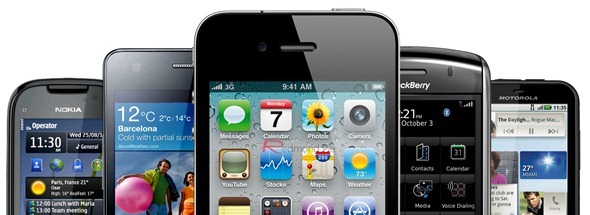Picture yourself back in the 2006 holiday season: if you were a geek, you were most likely struggling with your Windows Vista upgrade (those were the days!) and dreaming of owning that then-brand-new smartphone. More likely than not, it had a physical keyboard, had a rudimentary built-in web browser and definitely not a multi-touch display. When the iPhone first launched, the whole smartphone space was taken into a whole different direction.
As you can tell from the image below, Apple’s competitors have evolved greatly since the iPhone’s 2007 release, but there’s a pattern they all seem to have followed: all of Apple’s competitors now look like the iPhone in one way or the other. Back in 2006, the predominant form factors were clamshells and small screens surrounded by static plastic buttons, yet today most major smartphones don’t even have many physical buttons; in fact, most of their interface is comprised almost solely of a large multi-touch display, much like the iPhone.
Back when the iPhone was first announced at Macworld 2007, Steve Jobs made a sharp comparison between it and the other devices, portraying them as outdated and functionally flawed. After years of arguing for the importance of physical keyboard and dismissing the need for multi-touch functionality, it didn’t take long for all major players to adopt features they had previously criticized. While lousy at first, the tide began turning in 2009 with meaningful "iPhone killers" being introduced, most, if not all of them running Google’s Android operating system. Android, while significantly different from iOS, was clearly built to resemble it in both user experience and functionality with its touch-based interface and fluid web browser. Today, major players who had developed their proprietary operating systems in the past have all jumped on board to develop Android-based phones. Samsung, for example, developed its Galaxy line of smartphones and tablets which has been a runaway success.
While Android has been hugely successful, other makers have instead decided to evolve their own proprietary operating systems. This has led to a much more touch-friendly Symbian, which runs on Nokia phones, and a new version of the Blackberry OS that brings some of the features iOS users had been enjoying for quite some time.
Of course, all of Apple’s competitors attempt to emphasize the differences they have between each other, but in the end all share 90% of the features. We’ll have to wait until the next trend starts to watch everyone blindly following it. Yet, we can’t deny that touch-screen devices with decent web browsers are better with plastic dumb phones that could barely display Google.com correctly.
(via TNW)
You can follow us on Twitter or join our Facebook fanpage to keep yourself updated on all the latest from Microsoft, Google and Apple.

